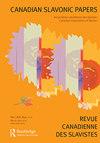Goncharov in the twenty-first century
IF 1.6
Q2 ETHNIC STUDIES
引用次数: 1
Abstract
nevertheless “accept and share the Holodomor as a common national tragedy” (113). This group and their descendants, in particular in the diaspora, make up a third community of memory. The fourth community of memory came to the fore in post-Soviet Ukraine and “consciously accepted the Great Famine as historical fact and postulated it as an act of genocide against the Ukrainian nation” (113). This community in Ukraine – in fact consisting of various communities of memory made up of individuals, social initiatives, and public activism as well as state activities – used eyewitness accounts of the Holodomor as a primary source to document Stalinist terror. Chapter 3 develops the discussion of the various religious and secular commemoration practices among the largest Ukrainian diaspora communities, especially in North America, Great Britain, Australia, and Brazil. It details the first initiatives in North America – including the building of a major symbolic and architectural commemorative achievement and place of memory – the Ukrainian Orthodox St. Andrew Memorial Church in South Bound Brook, New Jersey, in 1965 – as well as further memorial places elsewhere; this is always done in relation to the distinct purposes of the respective local community of memory. Chapter 4 likewise chronicles memory initiatives, but it does so in the context of Ukraine since perestroika and independence. It applies the lenses of “acting out” and “working through” trauma by way of engaging in memorial activities; the choice has been between a continuous state of mourning and a more “productive” investing of past suffering with meaning, something that also results in differing symbolic representations. In Chapters 5 and 6, discussion of the meaning and symbolism of monuments is elaborated upon by iconological and visual analysis of a whole range of monuments, memorials, and burial sites in Ukraine and in the diaspora, including at the major memorial site in Kyiv, built in 2008, and at the Washington, DC memorial that opened in 2015. The author views the symbolism of many such sites as being characterized by a mixture of Orthodox sacral or iconographical, folk and pagan, as well as secular references. Whereas at monuments and memorials in the diaspora “symbols of nation, religion, and human suffering prevail” (350), sites in Ukraine tend to “memorialize both the victims of the Holodomor and Stalinist repressions generally” (350). Eternal Memory is a very useful resource for students, general readers, and researchers in the fields of Ukrainian and post-Communist memory and monument studies.在21世纪的贡恰罗夫
然而,“接受并分享大饥荒作为一个共同的国家悲剧”(113)。这一群体及其后代,特别是散居国外的人,构成了第三个记忆社区。第四个记忆共同体在后苏联时代的乌克兰脱颖而出,“有意识地将大饥荒视为历史事实,并将其视为对乌克兰民族的种族灭绝行为”(113)。乌克兰的这个社区——事实上由各种记忆社区组成,这些记忆社区由个人、社会倡议、公共活动以及国家活动组成——将大饥荒的目击者描述作为记录斯大林主义恐怖的主要来源。第3章讨论了乌克兰最大的散居社区,特别是北美、英国、澳大利亚和巴西的各种宗教和世俗纪念活动。它详细介绍了北美的第一批举措,包括1965年在新泽西州南界布鲁克建造一座重要的象征性和建筑纪念成就和纪念场所——乌克兰东正教圣安德鲁纪念教堂,以及其他地方的更多纪念场所;这总是与各自的本地记忆社区的不同目的有关。第4章同样记录了记忆倡议,但它是在乌克兰改革和独立以来的背景下进行的。它通过参加纪念活动的方式,运用了“表演”和“克服”创伤的镜头;这种选择是在持续的哀悼状态和对过去的痛苦进行更有意义的“富有成效”的投资之间进行的,这也导致了不同的象征性表现。在第5章和第6章中,通过对乌克兰和散居国外的一系列纪念碑、纪念馆和墓地的图像学和视觉分析,包括2008年建造的基辅主要纪念馆和2015年开放的华盛顿特区纪念馆,详细讨论了纪念碑的意义和象征意义。作者认为,许多此类遗址的象征性特征是混合了东正教、圣教或图像学、民间和异教徒以及世俗参考。在散居国外的纪念碑和纪念馆中,“国家、宗教和人类苦难的象征盛行”(350),而乌克兰的遗址则倾向于“纪念大饥荒和斯大林主义镇压的受害者”。《永恒的记忆》对乌克兰和后共产主义记忆和纪念碑研究领域的学生、普通读者和研究人员来说是一个非常有用的资源。
本文章由计算机程序翻译,如有差异,请以英文原文为准。
求助全文
约1分钟内获得全文
求助全文

 求助内容:
求助内容: 应助结果提醒方式:
应助结果提醒方式:


